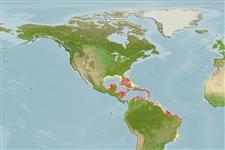Common names from other countries
Classification / Names / Names
Populaire namen | Synoniemen | Catalog of Fishes (gen., sp.) | ITIS | CoL | WoRMS
Environment: milieu / climate zone / depth range / distribution range
Ecologie
Benthopelagisch; diepteverspreiding 0 - 25 m (Ref. 97531), usually 0 - 5 m. Tropical
Western Atlantic: USA to Brazil.
Length at first maturity / Size / Gewicht / Leeftijd
Maturity: Lm ? range ? - ? cm Max length : 14.2 cm WD mannelijk/geslacht niet bekend; (Ref. 367); 9.5 cm WD (female)
Carapace slightly more than twice as broad as long; 9 teeth on arched anterolateral margin (outer orbital tooth and strong lateral spine included), second to eighth usually trending forward, without shoulders, anterior margins concave except first 2; front (excluding outer orbital angles) bearing 4 teeth, inner pair small but definitely formed. Anterior half of convex dorsal surface coarsely granulate, variably finer and more numerous granules on posterior on posterior part and in transverse lines; central trapezoidal (metagastric) area short and wide (anterior width about 2.4 times, posterior width about 1.5 times length). Pincers dissimilar, ridged longitudinally, fingers compressed but broadened dorsoventrally producing pointed spatulate shape; fifth legs flattened in form fifth legs flattened in form of paddles. Male with T-shaped abdomen reaching slightly beyond suture between thoracic sternites 4 and 5, sixth segment nearly parallel-sided but broadened proximally; first pleopods short, reaching about midlength of sternite 7, approximately each other or occasionally overlapping at level of abrupt curve beyond which short terminal part tapers to rather sharp tip; armed with minute scattered retrogressive spinules distally. Color: carapace brown with areas of bluish black. Chelae brown above; fingers dark on external face except for tips and proximal portion, internal face dark in distal 2/3; dark color of fingers retained in preservation.
Benthopelagic (Ref. 97531). Inhabits a variety of shallow environments to depths seldom exceeding 15 m, usually 5 m or less; found often in intertidal pools, on sand and muddy flats, algae and grass flats, sand beaches, rocky pools, eroded coral bases, oyster bars, shallows at edges of mangroves, and at the surface under light at night. Feeds on mollusks, other bottom invertebrates, and fishes, carrion and detritus (Ref. 367),
Life cycle and mating behavior
Geslachtsrijpheid | Voortplanting | Kuitschieten | Eieren | Fecundity | Larven
Members of the order Decapoda are mostly gonochoric. Mating behavior: Precopulatory courtship ritual is common (through olfactory and tactile cues); usually indirect sperm transfer.
Tavares, M. 2003. (Ref. 367)
Status op de Rode Lijst van het IUCN (Ref. 130435)
Status bij CITES (Ref. 108899)
Not Evaluated
Not Evaluated
Gebruik door de mens
Visserij: van minder commercieel belang
| FishSource |
Tools
Meer informatie
Leeftijd/GrootteGroeiLengte-gewicht parametersLengte-lengte parametersMorfologieLarvenAbundantie
Internet-bronnen
Estimates based on models
Preferred temperature
(Ref.
115969): 26.3 - 28.2, mean 27.4 (based on 546 cells).
Kwetsbaarheid
Low vulnerability (10 of 100).
